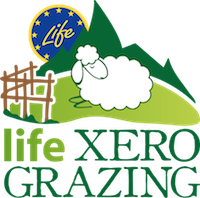Project
- In Eng
- Hits: 3449
 The purpose of the LIFE Xero-grazing project (Semi-natural dry-grassland conservation and restoration in Valle Susa through grazing management) is the conservation and the restoration of priority habitat 6210*, seminatural dry grasslands and scrubland facies on calcareous substrates (Festuco-Brometalia) (important orchid sites), within a representative pastoral area of the SCI IT1110030 “Oasi xerotermiche della Valle di Susa - Orrido di Chianocco e Foresto”. Today, it is affected by changes in the floristic composition and progressive invasion of trees and shrubs due to the absence of its use, for decades.
The purpose of the LIFE Xero-grazing project (Semi-natural dry-grassland conservation and restoration in Valle Susa through grazing management) is the conservation and the restoration of priority habitat 6210*, seminatural dry grasslands and scrubland facies on calcareous substrates (Festuco-Brometalia) (important orchid sites), within a representative pastoral area of the SCI IT1110030 “Oasi xerotermiche della Valle di Susa - Orrido di Chianocco e Foresto”. Today, it is affected by changes in the floristic composition and progressive invasion of trees and shrubs due to the absence of its use, for decades.
Within the SCI, this habitat is extremely significant due to the extent and the richness of orchids and the rare, steno-Mediterranean species. These grasslands in part, are already degraded because in the last decades land abandonment has produced a marked change in its floristic composition coupled with a dramatic encroachment by shrubs and trees.
The habitat 6210 * problems and threats to the conservation in the SCI are:
-Abandonment: the traditional agro-pastoral activities have been affected in recent decades by a progressive reduction in frequency and intensity. The shrinking number of resident companies and the exclusion of the area from the historical paths of transhumance flocks have contributed to a widespread abandonment of the area, which consequently has caused changes in the floristic composition of grasslands.
-Fire: Bassa Valle di Susa is considered to be an area at high risk for fire. In the SCI, the risk is accentuated by the large amount of dry ground phytomass and widespread shrub invasion - the consequences of the absence of agro-pastoral use.
-Unauthorized access of motor vehicles: In certain areas of the SCI, a problem with degradation of service roads to the areas of intervention exists, due to unauthorized access from motor vehicles.
-Changes of intended land use: land use changes within the SCI may be considered minimal, because the type of area and the territorial policies.
Project objectives:
The project aims to technically define and implement actions for the conservation and restoration of significant portions of the habitat. As a result, the project will be able to produce technical notes that the Alpi Cozie Natural Park (and other SCI areas) could apply to ensure a sustainable and long-term management of the habitat.
In particular, the project aims:
-To restore shrub and tree-encroached areas through actions of mechanical clearing and cutting. Even though the transition facies are included in the 6210 habitat, they can represent a threat for orchids;
-To define technical notes for a rational and conservative grazing management of the habitat and to apply them in particular areas (e.g. by buying domestic animals and arranging grazing structures);
-To develop the touristic and participative values of the area, increasing the awareness on the use of natural resources.
Through agro-pastoral character interventions, the project aims to restore about 20 hectares of 6210* habitat currently encroached by shrubs and trees as well as applying a conservative management to approximately 83 hectares of dry grassland.






 Project
Project